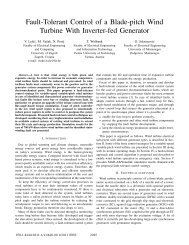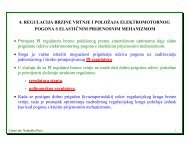Damping of Wind Turbine Tower Oscillations through Rotor Speed ...
Damping of Wind Turbine Tower Oscillations through Rotor Speed ...
Damping of Wind Turbine Tower Oscillations through Rotor Speed ...
You also want an ePaper? Increase the reach of your titles
YUMPU automatically turns print PDFs into web optimized ePapers that Google loves.
Pr = Pw⋅ CP.<br />
(3)<br />
The theoretical maximum for CP is<br />
determined by the Betz' law [1] and equals<br />
16/27. In practice wind turbines don't reach this<br />
limit but approach the value <strong>of</strong> 0.5 at best.<br />
CP is not a constant parameter but its value is<br />
dependant on wind speed v w , rotor speed ω<br />
and blade pitch angle β . <strong>Wind</strong> speed and rotor<br />
speed are usually bound together introducing<br />
parameter λ that is called tip speed ratio which<br />
represents the ratio between blade tip speed and<br />
wind speed [1]:<br />
ωR<br />
λ = . (4)<br />
v<br />
Typical dependence <strong>of</strong> performance<br />
coefficient upon tip speed ratio with pitch angle<br />
used as a parameter is shown in fig. 2.<br />
Figure 2: Performance coefficient as a function <strong>of</strong><br />
tip speed ratio.<br />
Aerodynamic torque Mr that drives wind<br />
turbine rotor and thus generator is given by:<br />
M<br />
r<br />
w<br />
( , )<br />
2 3<br />
P 1 ρairR πv r<br />
wCPλ β<br />
= = . (5)<br />
ω 2 ω<br />
Rearrangement <strong>of</strong> expression (5) yields:<br />
M<br />
r<br />
( , )<br />
3 2<br />
1 ρairR πvwCPλ β<br />
= . (6)<br />
2 λ<br />
A quotient <strong>of</strong> performance coefficient and tip<br />
speed ratio forms a new dimensionless<br />
parameter that is known as torque coefficient<br />
CQ [1]:<br />
C<br />
Q<br />
( λβ , )<br />
C<br />
( λ, β )<br />
P<br />
= . (7)<br />
Having aerodynamic torque calculated<br />
according to (6) rotor speed can easily be found<br />
using principle equation <strong>of</strong> motion:<br />
λ<br />
J � ω = M −M −M<br />
, (8)<br />
t r g l<br />
where Mg is generator electromagnetic torque,<br />
Jt is total moment <strong>of</strong> inertia <strong>of</strong> rotor and<br />
generator while Ml is loss torque. Loss torque<br />
Ml, caused mostly by friction is rather small<br />
and will be neglected here.<br />
In this paper we consider wind turbine with<br />
generator that is directly coupled with turbine<br />
rotor. This turbine setting known as direct drive<br />
system uses synchronous multipole generator<br />
that rotates at small speed <strong>of</strong> turbine rotor.<br />
Since rotor and generator speeds are the same<br />
no distinction between them is made<br />
<strong>through</strong>out the paper. Because there is no<br />
gearbox between rotor and generator their<br />
moments <strong>of</strong> inertia can just be summed<br />
together in order to calculate total moment <strong>of</strong><br />
inertia Jt. The coupling <strong>of</strong> rotor to the generator<br />
in direct drive solutions is very stiff and it can<br />
be considered as rigid thus removing any<br />
torsional oscillations what simplifies the<br />
control system design.<br />
Before going further an important issue has<br />
to be addressed. Namely, expressions (4), (5)<br />
and (6) in this form would be valid only for<br />
structure with rigid tower and blades. In real<br />
situation the absolute wind speed v w in<br />
mentioned expressions has to be replaced by<br />
wind speed that is "seen" by rotor blades. This<br />
wind speed seen by the rotor is the resultant <strong>of</strong><br />
three factors: absolute wind speed v w , speed<br />
<strong>of</strong> the tower movement perpendicular to wind<br />
speed (i.e. tower nodding speed) x� t and speed<br />
<strong>of</strong> blade movement perpendicular to wind<br />
speed (i.e. speed <strong>of</strong> blade flapwise movement).<br />
Influence <strong>of</strong> tower nodding on wind turbine<br />
control is much more pronounced than<br />
influence <strong>of</strong> blade flapwise movement.<br />
Therefore we focus only on tower nodding<br />
considering rotor blades as rigid.<br />
<strong>Tower</strong> nodding originates from the fact that<br />
wind turbine tower is very lightly damped<br />
structure due to its great height (more than 100<br />
meters in modern wind turbines) and need for<br />
moderate mass. To model the wind turbine<br />
tower precisely we would have to use model<br />
with distributed parameters and to describe it<br />
in terms <strong>of</strong> mass and stiffness distribution.<br />
Such a model wouldn't be very suitable for<br />
controller design so it has to be substituted by







